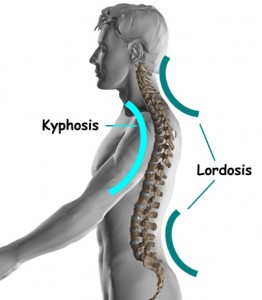Poor Posture Can Equate to Lower Back Pain
 Lower back pain….I can’t tell you how many people I’ve met through my years practicing chiropractic that suffer from this. As with the neck and middle back, posture is a huge contributor. The good news is that there is a lot that you can do to impact your lower back posture and reduce your pain – not to mention get people around you to think you’ve grown taller!
Lower back pain….I can’t tell you how many people I’ve met through my years practicing chiropractic that suffer from this. As with the neck and middle back, posture is a huge contributor. The good news is that there is a lot that you can do to impact your lower back posture and reduce your pain – not to mention get people around you to think you’ve grown taller!
For my final posture blog, I want to address the low back posture. Normal posture of the low back should include a nice C curve, with the arc of the C facing forward when looking from the side.
“Sway” back
By far the most common postural problem in the low back is the anteriorly tilted pelvis. This can make someone appear as though they are scooping their butt up and back and sticking their stomach out in the front. This posture is sometimes referred to as “sway ” back.
Sway back can:
- Put excessive stress on the discs
- Eventually cause wear and tear that results in disc degeneration
- Put additional pressure on the joints that allow the spinal segments to move and track on the ones above and below
- Increase the likelihood of low back pain
When there is an imbalance in the core and hip muscles, people often experience lower back pain. Here’s how this happens:
Say you have a weakness in your glutes, abs and hamstrings – the muscles that work together to pull your pelvis back. At the same time, your hip flexors, quads and spinal erectors are overly active and tightened – the muscles that work together to pull your pelvis forward. The combination results in an exaggerated curve in your lower back. Where is this combination most common? In people with a sedentary lifestyle or people who sit for many hours daily in their jobs (the latter being so common in today’s working world!).
“Flat” back
A less common problem is having a decreased curve in the low back. This type of posture can make a person appear as if they are slouching and as if they are tucking their butt in. Flat back can:
- Create trigger points and chronic strain on the muscles
- Increase the risk of compression fractures in the lumbar spine due to the increased stress on the front of the discs causing them to wear out faster.
- Increase the likelihood of lower back pain
Flat back happens because often the hip flexors and trunk extensors are weak while the abdominal muscles are strong.
With either posture condition, the solution comes down to creating proper muscle balance in the core, hip and back. The best fix is to strengthen the lower abs and what’s called the posterior chain, which includes the glutes, hamstrings and low back muscles. In our office, we start people off with the pelvic tilt and then eventually move them into doing a bridge. While strengthening these muscles, it is equally important to stretch the hip flexors and quads.
As well, maintain good posture while sitting to prevent slouching. Use a lumbar support to fill up the space created by the curve in the low back (note: a towel can be rolled up and placed behind the back). Low back support cushions can easily be found online as well as in our office! Always be sure that the feet are at waist level or higher to reduce stress on the back and maintain good posture. Use a flip up foot stool to bring the knees up.
The bottom line: Don’t let your posture go! Work on it by strengthening the right muscles and putting assists in place to help you have good posture, especially when sitting. Believe me…your lower back will thank you.
Here’s a great lower back exercise – give it a try!


Write a Comment